Part 93: 8/10/09-8/14/09
8/10/09We’re in for a week of summer school, starting today.
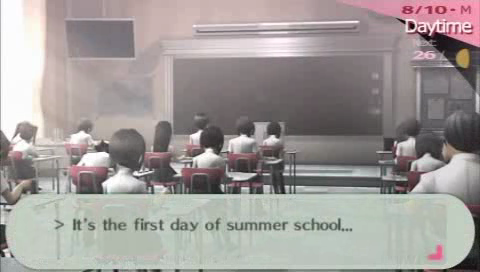
> Despite the heat, the lecture continues…
If there’s anything interesting I guess I’ll write about it.
8/11/09
I think Edogawa’s talking about something relevant to us this time.
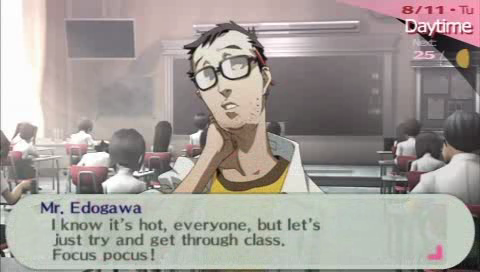
 You must all be very curious students to be taking this course over the summer.
You must all be very curious students to be taking this course over the summer.…I’m not really sure what to make of that. Eeeheehee…
Well, let’s talk about something interesting today.
All you future magicians will want to pay close attention… Eeeheehee…
Today’s subject is Tarot. That’s right, those cards often used in fortune-telling.
Originating in 15th century Europe as normal playing cards, tarot cards evolved into tools of divination.
A variety of different versions of tarot card decks exist, including the Marseille and Rider decks…
But today, in respect of the great magician Crowley, we will be using the Thoth deck.
First, let’s talk about the composition of the deck…
The modern 78-card tarot deck is divided into two parts.
There are 22 Major Arcana—the face cards—and 56 Minor Arcana, or number cards…
The Minor Arcana are also sometimes called pips.
The Major Arcana feature a variety of illustrations on their faces.
Beginning with “The Fool” and ending with “The World”…
…they tell a story in numerical order that is a metaphor of an individual’s journey through life.
Each Major Arcana represents a stage on that journey…
…an experience that the individual must incorporate to realize his oneness.
I wonder what it means that the Shadows and our Personas all seem to be associated with one of these Arcana.
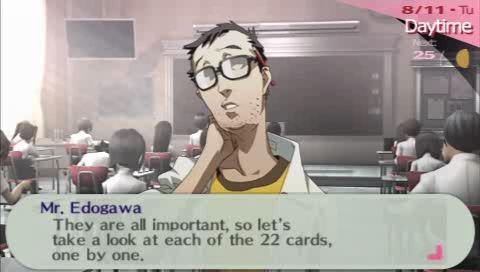
 The first card, numbered 0, is The Fool. It represents the beginning and suggests infinite possibilities.
The first card, numbered 0, is The Fool. It represents the beginning and suggests infinite possibilities.The next card, The Magician, represents action and initiative… but also immaturity.
The Priestess represents contemplation and inner knowledge.
The Empress represents motherhood and the life it brings forth.
The Emperor is an opposing card. It represents fathering and relates to leadership and decision-making skills.
The Hierophant represents formality and knowledge, and stands for religion.
The Lovers card represents choice. Here, the individual’s consciousness has finally surfaced.
The Chariot represents victory for the individual, but only a momentary one.
Justice represents the knowledge of what is right, and what is wrong.
The Hermit represents the individual’s search for answers by looking inward, deep inside his heart.
Fortune represents fate, and the opportunities that come with it.
Strength represents both passion and self-control. It is depicted as power with reason.
The Hanged Man reflects the individual’s inability to take action.
Spiritual death awaits the individual with the 13th card, which is aptly named Death.
Death is considered a transitional card…
The old ends, and the new begins.
Come to think of it, I don’t remember any Shadows from Death or beyond.
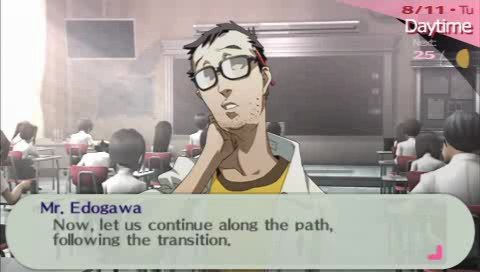
 Temperance is the balancing of opposites. Opening his eyes to the world allows the individual to grow…
Temperance is the balancing of opposites. Opening his eyes to the world allows the individual to grow…And as The Devil represents, he then faces temptation…
At The Tower, his values collapse on him. It seems as if he no longer has anything to believe in, but…
…he then finds a glimmer of hope, represented by The Star; and he is suffused with a serene calm.
This bliss makes him vulnerable to the illusions of The Moon.
Fears arise, and he follows the dim path in his heart with trepidation…
But he is reward with a bright future, represented by The Sun, which signifies true achievement.
Judgement awaits the individual at the end of his journey, as he looks back on the path he has traveled.
The final card is The World, which represents the individual’s full awareness of his place in the world.
That is the growth of an individual as explained by the tarot cards.
…Perhaps all this talk about life doesn’t hit home with you young folks just yet, hm? Eeeheehee…
Now, you can use all 78 cards to divine the future in detail…
…but most people only use the 22 Major Arcana.
Okay. Next, let’s talk about how to tell fortunes using the Major Arcana.
First, you will need to shuffle the cards.
If a card is reversed, its meaning will change, so it’s important…
> The class continues…
I guess I’ll have to keep all this in mind…
8/14/09
Edogawa was back with some weird lecture again.
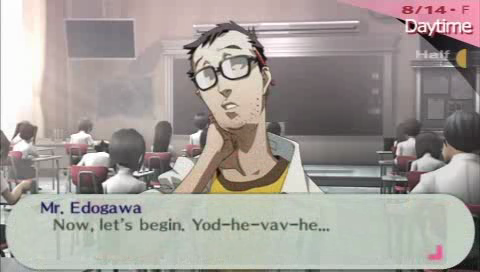
 How are you all handling the heat? …I could brew you some of my special tea if you’d like. Eeeheehee…
How are you all handling the heat? …I could brew you some of my special tea if you’d like. Eeeheehee…Now, let’s continue with our special summer study—The Truth Behind Magic.
I’ll be talking about “Kabbalah.”
I assume all of you have at least heard of Kabbalah, yes.?
It is known as the mystical study of the Hebrew scriptures, but…
…as I have mentioned before, it has had a great impact on western sorcery.
It has been said that to learn the secrets of magic, first you must truly understand Kabbalah.
So, who was the person who formed this incredibly ideology known as Kabbalah?
Well, according to legend, it was Moses.
Yes, THAT Moses. The Moses who gave us the Ten Commandments and split the Red Sea.
But in reality, it was formulated by a group of rabbis long, long ago.
However, because it consists of such a complicated coded system…
Kabbalah did not become known to the western world until much later.
Now, it is important to note that there are many different ancient methods of deciphering Kabbalah.
All these words kind of remind me of how the blocks in Tartarus are named, I guess maybe they come from Kabbalah somehow?
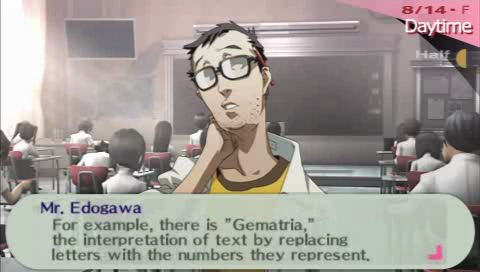
 There is “Notarikon,” where you take a letter from each word to form another sentence or thought.
There is “Notarikon,” where you take a letter from each word to form another sentence or thought.There is also “Temurah,” a method where letters of words are replaced, thereby giving the sentence a new meaning.
All these different methods make it difficult to fully comprehend Kabbalah.
Now, one of the most important ideas of Kabbalah is the Tree of Life, formed of the ten Sefirot.
Most illustrations depict it as a chart shaped like a tree.
The 10 stages represented by the Sefirot…
…and the 22 paths connecting them represent the stages of Creation God formed from his own self, as well as the direction in which humanity should evolve.
Where did we come from? Where are we going? These answers lie in the Sefirot.
When training your magic, it’s important to picture the Sefirot every so often.
And when you are meditating, you should focus on the Sefirot as well.
If life was a test, the Sefirot would be the basic questions. All aspiring magicians should know them.
So, if you’re looking for inspiration, try your hand at the Sefirot. Eeeheehee…
I’m not sure how it works exactly.
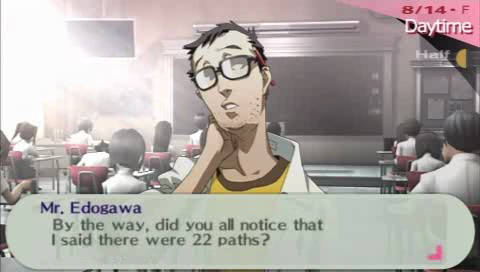
 Yes, that’s right. The same number as the Major Arcana I spoke about earlier. Eeeheehee…
Yes, that’s right. The same number as the Major Arcana I spoke about earlier. Eeeheehee…Now, continuing on, according to the Sefirot, the world is broken up into four stages…
> The class continues…
> Despite the heat, the lecture continues…
 Oh, before I forget…
Oh, before I forget…I’ll be giving supplementary lessons at the Nurse’s Office, starting in the second term.
I’m thinking of doing demonstrations using Tarot cards.
But I won’t have time for that during the lecture… If you’re interested, stop by after school.
Everyone is welcome. Eeheehee…
Guess we’ll figure it out if it’s important. Anyway I think Junpei has actually died, at least on the inside.